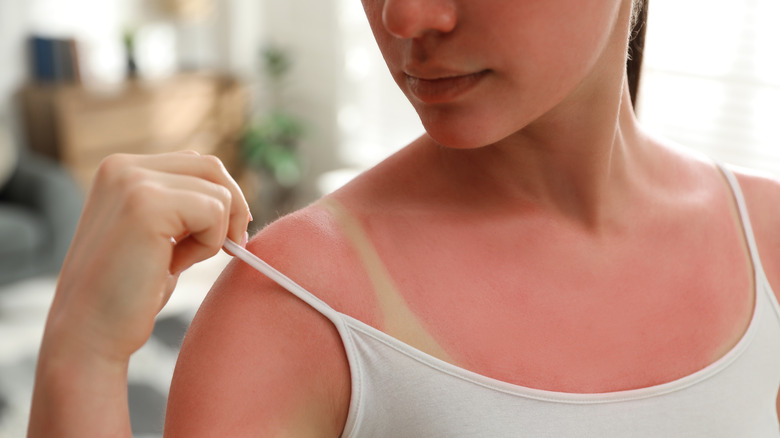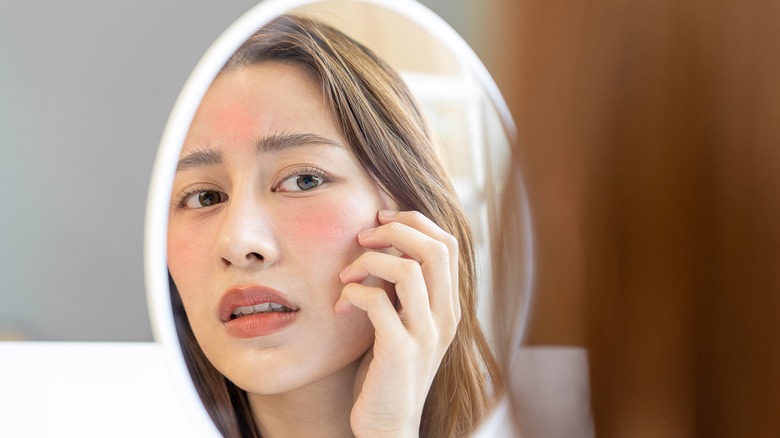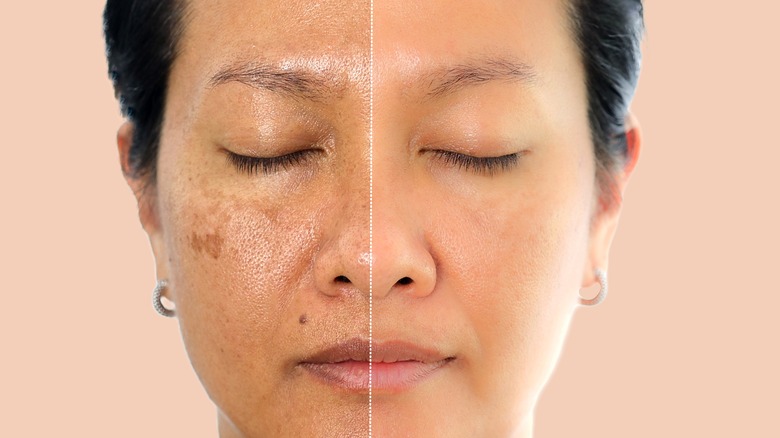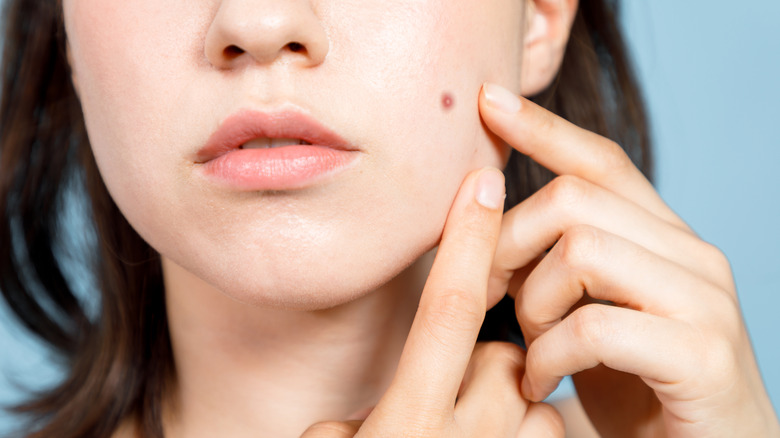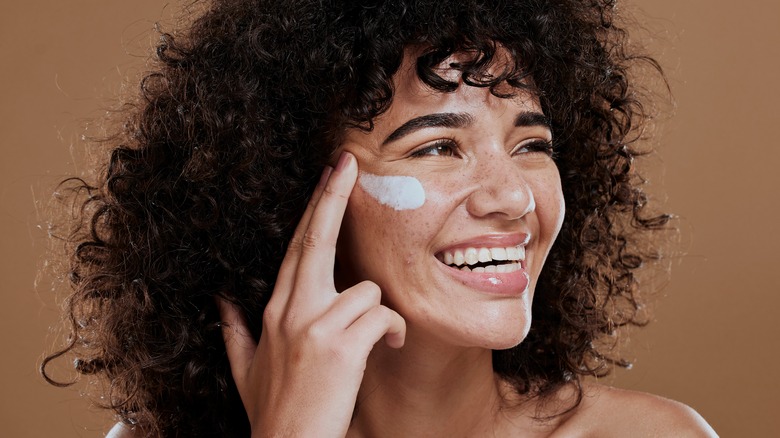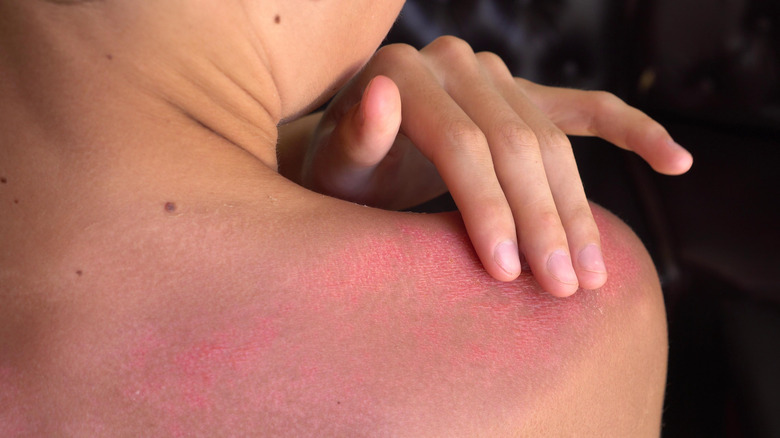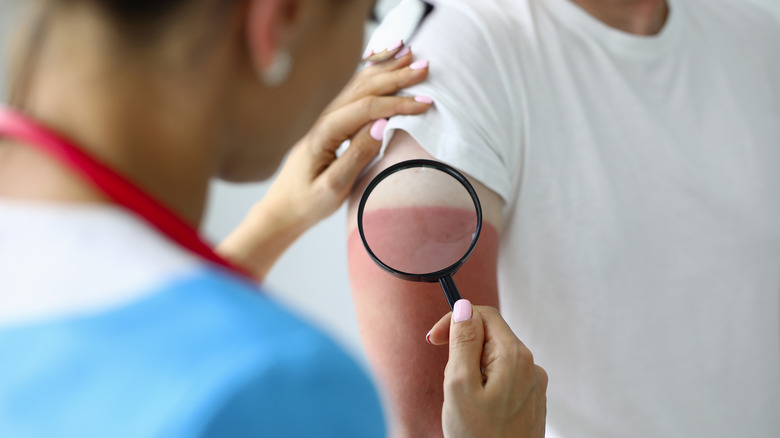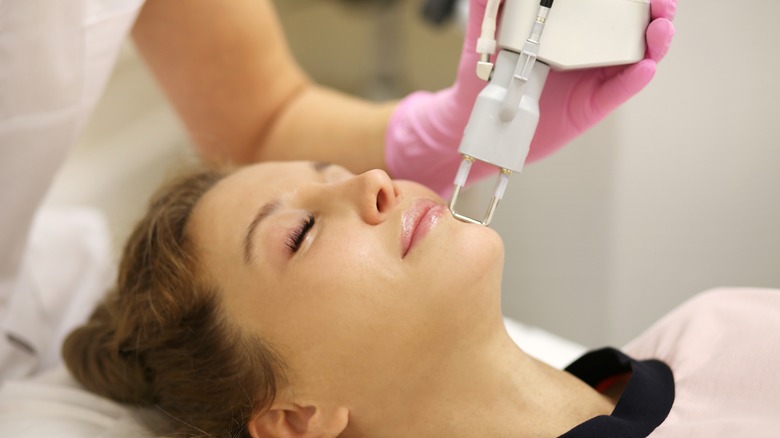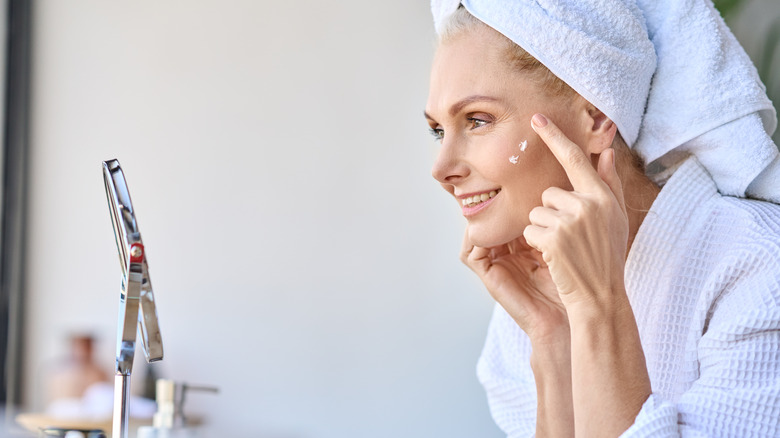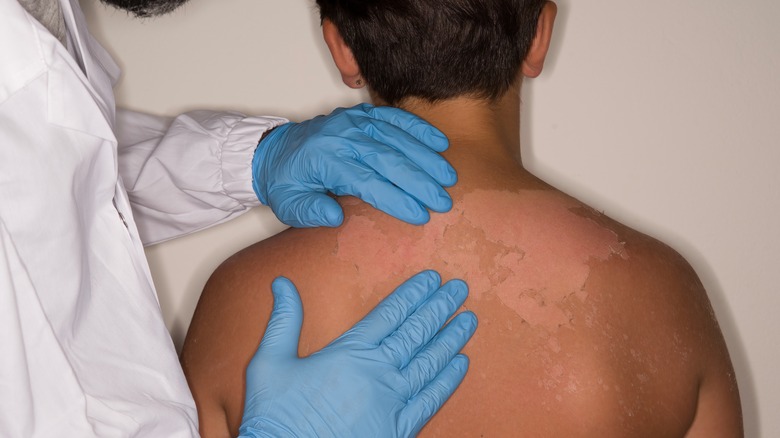Is Sun Damage Reversible (& Can SPF Help With It)?
As all of our thoughts turn to times of frolicking in the sun and spending hours in the sand, there's probably something most of us are forgetting — the sun damage that can be induced from unprotected time spent in the sun. Sure, many of us might have a thought or two about wearing SPF, and some might even be committed to slathering an SPF product on our faces every day. Even so, as more of our skin is exposed during the warmer months of the year (and yes, you still need to wear SPF in the winter), we may tend to forget about applying sun protection to every part of our bodies.
So you've gotten a sunburn or two in your lifetime. Maybe you've noticed a few dark spots that didn't go away when your sunburned skin did. Perhaps you've just been put on the idea of how badly the sun can damage your skin. So what are you to do now? Fortunately, there's a lot of evidence that sun damage can be reversed, and most dermatologists agree that there is hope for everyone with some kind of sun damage on their body. Whether it's age spots, spider veins, or a blotchy complexion, there are ways to treat those problems and effectively "reverse" those signs of sun damage.
What is sun damage?
Before we start on what we can do to reverse any sun damage you might have gotten in your youth (or anytime since then!), let's discuss together just what sun damage is. Sometimes, sun damage is quite visible, while other times, it's hidden or disguised and can present in many forms.
Sun damage is caused by UV radiation from the sun, which is "a form of electromagnetic energy," according to Healthline. The sun's UV radiation is further divided into UVA, UVB, and UVC radiation — of these, UVC radiation is filtered out by the atmosphere, and UVA rays make up 95% of the sun's rays while UVB makes up the rest, 5%.
Usually, we think of sun damage as sunburns, but these are caused mainly by the UVB rays of the sun. UVA rays, on the other hand, work under the surface of your skin and bring about sun damage that only is visible after many months or even years. UVA rays can contribute to drooping, wrinkles, loss of skin elasticity, thinner skin, broken capillaries, age spots, dry or rough skin, and skin cancers. Plus, there is even more damage that is done at a cellular level and even at the DNA level.
Where does sun damage appear?
If you think about it just a bit, you'll probably come up with the areas of your body where you're most likely to see sun damage. But we'll spare you the burden — Epiphany Dermatology says we should all be wary of our "face, arms, legs, hands, scalp, ears, neck, and chest" since those areas are usually exposed to the sun's rays, especially during the warmer months.
Many of us are diligent about applying sunscreen to our faces, and products that we wear every day sometimes also contain sunscreen so that we don't even have to try very hard. But, unfortunately, most of us forget about the other spots on our bodies. The neck is especially susceptible to sun damage as well as the chest area. We forget about protecting these parts of our bodies, and, in fact, we even expose them more during warmer months.
Our hands and legs also need sun protection as they are constantly exposed to UVA and UVB rays. And not just on sunny or hot days either — Healthline warns that even on a "cloudy day," the sun's UV rays penetrate the cloud cover and can cause harm. So your hands, which are often exposed, will get the brunt of UV radiation. That's why many people's hands show signs of aging, sometimes even quicker than the rest of their bodies.
Types of sun damage on the skin
Sun damage is usually thought of as just sunburned skin, but other, more subtle, types of damage can happen over time. Sunburns themselves are to be taken seriously, though. The Cleveland Clinic says that "a sunburn is actually a radiation burn to your skin" and should be avoided whenever possible, as multiple sunburns throughout your lifetime can lead to a higher risk of cancers and premature skin aging.
Most people get first or second-degree burns to their skin from the sun's rays. First-degree burns will usually resolve themselves in a few days to a week, while second-degree burns will result in damage to "the inner layer of your skin" and may need additional treatment — especially if blisters form. Only in very rare cases will someone get a third-degree burn from the sun that requires medical intervention and hospitalization.
Other than sunburns (which show up almost immediately to signify sun damage), prolonged, unprotected exposure to the sun can also lead to other kinds of damage that only show up later. The American Academy of Dermatology (AAD) also calls this kind of damage "photoaging," and it includes problems such as wrinkles, age spots, loose skin, and a "blotchy or ruddy complexion."
Types of sun damage in the eyes
Besides your skin, the eyes are the only other body part constantly exposed to the sun. Many of us don't think about the kind of damage that the sun can have on our eyes, but it can sneak up on you when you least expect it — especially if you don't wear proper UV eye protection when you're out and about.
The American Academy of Ophthalmology lists five kinds of eye damage that can be caused by the sun, including corneal sunburn, cataracts, growths on the eye, macular degeneration, and even eye cancers. One of the most common kinds of eye damage from the sun is corneal sunburn, caused by unfiltered UV radiation from the sun for an extended period of time and is most common after exposure to reflective surfaces such as snow, which is why it is sometimes called "snow blindness."
The other kinds of sun damage — cataracts, eye cancers, growths on the eye, and macular degeneration — may occur after several years of exposure, so they will not be immediately noticeable. But that doesn't mean that you shouldn't take preventative steps to keep your eyes sunburn-free today.
How to check yourself for sun damage
Sometimes sun damage can be very obvious — if you're bright pink, for example — but sometimes it's not. Sun damage can present itself as wrinkles, age spots, spider veins, and a blotchy complexion, with many of these symptoms showing up only after repeated exposure to the sun or many days, weeks, or even months after the initial sun damage.
The American Cancer Society suggests doing monthly skin checks to stay aware of the changes or problems that might be happening with your body. Conduct your check in a room with proper lighting. A "full-length mirror" and a "hand-held mirror" may be helpful tools for a smooth process. The first time you do a check yourself, memorize or record the location of any moles and their sizes, shapes, and color so that you know the next time if any changes have happened.
You should also be on the lookout for moles, spots, or growths that are "changing in size, shape, or color" and have "irregular borders." Sores or patches that bleed and don't heal in a timely manner could also be indications of skin cancers. And, of course, look for signs of premature aging which include new wrinkles, age spots, or spider veins.
Are you using enough SPF?
Sun protection factor (SPF) measures how long a product will protect your skin from burning once it's applied. Of course, this also has to be measured in combination with just how easily your skin burns. SPF usually ranges in scale from 15 to 50, although some products have a lower or higher SPF.
To determine the SPF number you need for your skin and your environment, The Derm Collective says to first think about how fast your skin burns when you don't apply SPF. Take that number and multiply it by the SPF — that total (in minutes) is the amount of time your skin is protected. For example: If you burn after 20 minutes, then applying an SPF of 15 would multiply those 20 minutes by 15 and give you a total of 300 minutes, or 5 hours (of course, that's barring any removal of the SPF by swimming or sweating).
Ok, you've determined the SPF you need for your skin type and time outdoors. But are you applying enough of that sunscreen to actually cover and protect yourself like the bottle claims? Dr. David Lortscher, a board-certified dermatologist and founder of Curology, tells Healthline that most people "aren't using enough" SPF to take advantage of its benefits. We need about "2 milligrams per square centimeter of skin," which equates to about ¼ of a teaspoon "for your face alone," not to mention the rest for your neck, chest, ears, and other exposed skin.
How to deal with fresh sun damage at home
Most of the time, immediate and fresh sun damage presents in the form of a sunburn. In such cases, there are several ways that you can "treat" your sun damage. Doing so won't heal your skin or reverse any sun damage already done, but it can help you through the time and pain until your body deals with the damaged skin and get rid of the damaged layer.
To treat sunburns at home, above all else, be gentle with your body. Sunburns take some time to heal, depending on the severity. The Mayo Clinic recommends using a moisturizing lotion or gel on the affected areas plus a wet, cool cloth for 10 minutes at a time, several times a day. Additionally, drink plenty of water to keep your body hydrated through the process and take a pain reliever if you need to. If peeling or blistering skin causes itchiness, consider taking an anti-itch medication. Lastly, stay out of the sun for a period of time until your skin heals.
Sunburned eyes can also be treated at home as long as your symptoms are not too severe. Keep any contacts out of your eyes until symptoms subside, and apply a cool, wet cloth to your face to help your eyes and relieve some of the 'hot' sensations. Make sure not to rub your eyes, even if you have itchiness — instead, use some anti-itch eye drops or lubricant tears, advises Healthline.
Is your fresh sunburn severe?
In rare cases, you might even need to be hospitalized for severe sunburns. The Skin Cancer Foundation says you should consult a doctor whenever your sunburns are severe enough to be accompanied by blisters "over a large part of your body." You should also see a doctor if your sunburn causes fever, chills, or nausea.
Additionally, a sunburn can become infected, at which point a doctor will have to prescribe antibiotics. Fortunately, cases of infection are pretty rare with sunburns, and a doctor visit will end with either a corticosteroid cream or prednisone being prescribed. In severe cases, you may be admitted to the hospital for additional treatment.
"Patients who have blistering on the skin or systemic symptoms such as fever, dehydration, vomiting, and severe pain should consider seeking medical attention," Christopher da Fonseca, M.D., a family medicine physician, tells Baptist Health South Florida. "Sometimes, patients may require hospitalization for IV fluids and pain control."
Treating long-term sun damage in office
A dermatologist is usually much more equipped to take care of long-term sun damage in their office than you would be at home. The American Academy of Dermatology says there are "different types of treatments" for long-term sun damage, and your doctor's recommendation depends on the severity of the damage. These treatments are not meant to reverse the damage of the sun's UV rays, but they can help with the visible damage of premature aging.
The American Academy of Dermatology recommends microdermabrasion for sun damage such as wrinkles, age spots, and a blotchy complexion. A doctor can also use injectable fillers or Botox, chemical peels, or laser resurfacing to fix the appearance of wrinkles. Age spots, blotchy complexions, and spider veins can be lessened in appearance with intense pulsed light, laser resurfacing, and even cryosurgery.
A final (very important) note: Make sure you're getting these treatments from a board-certified dermatologist, not just anyone that offers these treatments. This is important because an inexperienced individual might not recognize the difference between an age spot and what might already be skin cancer.
Treating long-term sun damage at home
Although sometimes not as effective as in-office treatments, treating long-term sun damage can also be treated at home with certain ingredients or prescriptions. Niacinamide, azelaic acid, topical retinol/retinoids, vitamin C, and alpha hydroxy acids are someingredients that you can find in products over the counter to heal some signs of skin damage from the sun.
Dr. David Lortscher told Healthline that niacinamide can "minimize dark spots and hyperpigmentation," acting as an "antioxidant." Niacinamide can be found in serums and moisturizers and can help with evening out skin tone and boost the skin's elasticity. Azelaic acid can "help reduce marks left by acne," Dr. Lortscher explains, and it is "less irritating" than tretinoin which is a prescription form of retinol (which is also being used for skin healing).
Vitamin C, on the other hand, works to help prevent sun damage from even occurring. Vitamin C "is a super ingredient that has anti-aging benefits and repairs existing skin damage," Dr. Lortscher says, adding that "It also helps rebuild your skin's structure by stimulating collagen production, a protein that makes up your connective tissue and gives your skin its structure."
Is sun damage completely reversible?
Dr. Susan Bard, a board-certified dermatologist at Manhattan Dermatology Specialists, tells CNET that sun damage is reversible — but only "partially." "It is possible to reverse [sun damage] to some extent utilizing lasers, chemical peels, and certain topical medications to destroy dark spots and vessels, encourage collagen deposition and remove the damaged layers of skin," Dr. Bard explains. This means that, aesthetically, you can reverse the signs of sun damage to your skin.
But that doesn't mean it's totally fixable. The sun damage that isn't reversible has to do with the damage that is done in the DNA of each individual cell. "Once DNA mutation has occurred due to UV irradiation, there is no way to undo that. The cell needs to be destroyed by an outside modality or by the body," she explains. Additionally, even if you work to reverse some of the damage that the sun has caused, over time, it may continue to add up and create more and more signs of aging.
How to prevent sun damage in the future
Prevention is the best offense when it comes to the sun's damaging rays. It's no secret that wearing sunscreen every day is crucial for our health, as well as our appearance from sun damage. "Taking care of your skin is not only important for anti-aging purposes but also to prevent skin cancer," board-certified dermatologist Dr. Jeannette Graf tells Greatist. "Make sure you are applying sunscreen daily and reapply throughout the day."
It's important to choose the right sunscreen for your skin and use a broad-spectrum, water-resistant SPF to block out both UVA and UVB rays on a daily basis to cover you in any instance of incidental exposure, such as when you're walking to the coffee shop or running in the park. You may also benefit from wearing long-sleeve shirts or pants, wide-brimmed hats, and sunglasses when you're outside. Also, it's best to limit time in the sun between the times of 10 a.m. and 4 p.m. when the sun's rays are the strongest.

